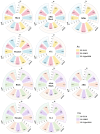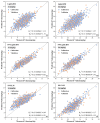Heavy Metal Concentration Estimation for Different Farmland Soils Based on Projection Pursuit and LightGBM with Hyperspectral Images
- PMID: 38794105
- PMCID: PMC11125194
- DOI: 10.3390/s24103251
Heavy Metal Concentration Estimation for Different Farmland Soils Based on Projection Pursuit and LightGBM with Hyperspectral Images
Abstract
Heavy metal pollution in farmland soil threatens soil environmental quality. It is an important task to quickly grasp the status of heavy metal pollution in farmland soil in a region. Hyperspectral remote sensing technology has been widely used in soil heavy metal concentration monitoring. How to improve the accuracy and reliability of its estimation model is a hot topic. This study analyzed 440 soil samples from Sihe Town and the surrounding agricultural areas in Yushu City, Jilin Province. Considering the differences between different types of soils, a local regression model of heavy metal concentrations (As and Cu) was established based on projection pursuit (PP) and light gradient boosting machine (LightGBM) algorithms. Based on the estimations, a spatial distribution map of soil heavy metals in the region was drawn. The findings of this study showed that considering the differences between different soils to construct a local regression estimation model of soil heavy metal concentration improved the estimation accuracy. Specifically, the relative percent difference (RPD) of As and Cu element estimations in black soil increased the most, by 0.30 and 0.26, respectively. The regional spatial distribution map of heavy metal concentration derived from local regression showed high spatial variability. The number of characteristic bands screened by the PP method accounted for 10-13% of the total spectral bands, effectively reducing the model complexity. Compared with the traditional machine model, the LightGBM model showed better estimation ability, and the highest determination coefficients (R2) of different soil validation sets reached 0.73 (As) and 0.75 (Cu), respectively. In this study, the constructed PP-LightGBM estimation model takes into account the differences in soil types, which effectively improves the accuracy and reliability of hyperspectral image estimation of soil heavy metal concentration and provides a reference for drawing large-scale spatial distributions of heavy metals from hyperspectral images and mastering soil environmental quality.
Keywords: LightGBM; hyperspectral image; local regression estimation; projection pursuit; soil heavy metals.
Conflict of interest statement
The authors declare no conflicts of interest.
Figures











Similar articles
-
[Estimating heavy metal concentrations in topsoil from vegetation reflectance spectra of Hyperion images: A case study of Yushu County, Qinghai, China.].Ying Yong Sheng Tai Xue Bao. 2016 Jun;27(6):1775-1784. doi: 10.13287/j.1001-9332.201606.030. Ying Yong Sheng Tai Xue Bao. 2016. PMID: 29737683 Chinese.
-
Effects of hyperspectral data with different spectral resolutions on the estimation of soil heavy metal content: From ground-based and airborne data to satellite-simulated data.Sci Total Environ. 2022 Sep 10;838(Pt 2):156129. doi: 10.1016/j.scitotenv.2022.156129. Epub 2022 May 21. Sci Total Environ. 2022. PMID: 35605855
-
Estimation of the spatial distribution of heavy metal in agricultural soils using airborne hyperspectral imaging and random forest.J Hazard Mater. 2020 Jan 15;382:120987. doi: 10.1016/j.jhazmat.2019.120987. Epub 2019 Aug 17. J Hazard Mater. 2020. PMID: 31454609
-
Hyperspectral indirect inversion of heavy-metal copper in reclaimed soil of iron ore area.Spectrochim Acta A Mol Biomol Spectrosc. 2019 Nov 5;222:117191. doi: 10.1016/j.saa.2019.117191. Epub 2019 Jun 6. Spectrochim Acta A Mol Biomol Spectrosc. 2019. PMID: 31247388 Review.
-
A meta-analysis of heavy metals pollution in farmland and urban soils in China over the past 20 years.J Environ Sci (China). 2021 Mar;101:217-226. doi: 10.1016/j.jes.2020.08.013. Epub 2020 Sep 3. J Environ Sci (China). 2021. PMID: 33334517 Review.
References
-
- Hartemink A.E. The Definition of Soil Since the Early 1800s. In: Sparks D.L., editor. Advances in Agronomy. Volume 137. Elsevier; Amsterdam, The Netherlands: 2016. pp. 73–126.
-
- Lwin C.S., Seo B.-H., Kim H.-U., Owens G., Kim K.-R. Application of soil amendments to contaminated soils for heavy metal immobilization and improved soil quality-a critical review. Soil Sci. Plant Nutr. 2018;64:156–167. doi: 10.1080/00380768.2018.1440938. - DOI
-
- Wang F., Gao J., Zha Y. Hyperspectral sensing of heavy metals in soil and vegetation: Feasibility and challenges. Isprs J. Photogramm. Remote Sens. 2018;136:73–84. doi: 10.1016/j.isprsjprs.2017.12.003. - DOI
Grants and funding
LinkOut - more resources
Full Text Sources
Research Materials
Miscellaneous

